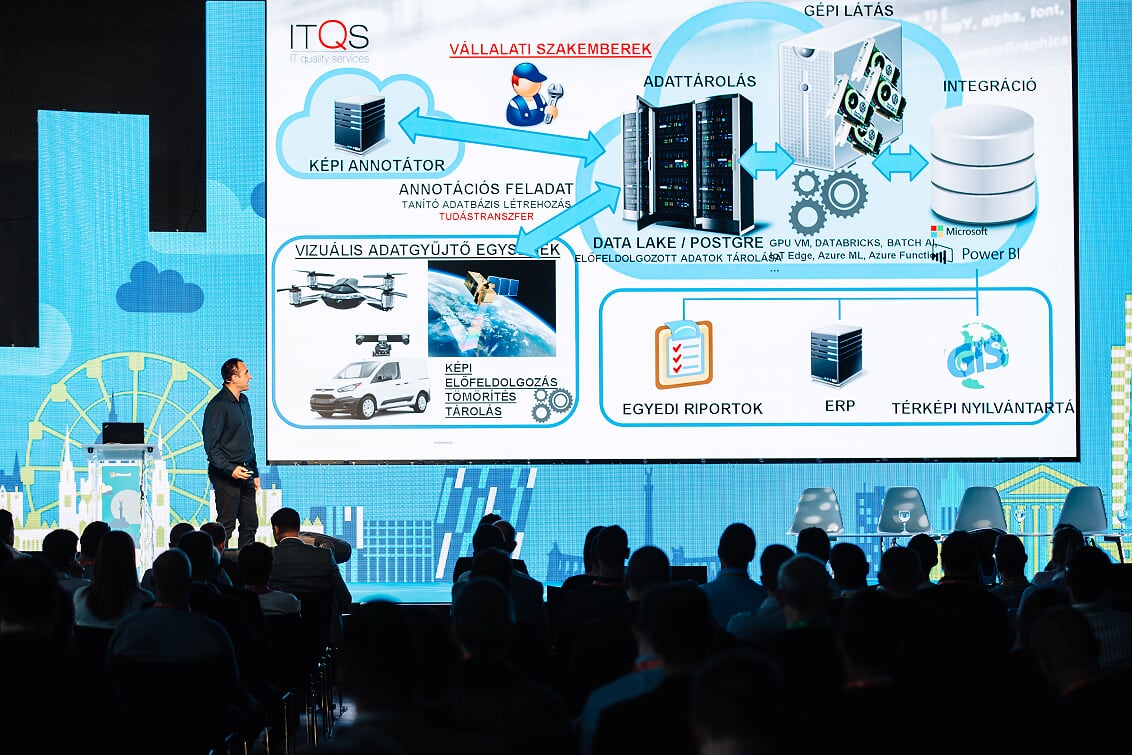The good thing about artificial intelligence (among others) is that it can be taught to recognise practically anything. Not only can it differentiate a cancerous tumour from healthy tissue, not only can it recognise faces, it can also identify components and faults in electricity transmission lines if need be. And this is precisely what E.ON needs.
31 thousand kilometres, 28 thousand hours. This first is the length of the transmission line network that E.ON’s specialists have to inspect, and the second is the amount of time spent with this. No wonder the technicians only return to the same point on the network every three years on average, explained László Pintér, Head of Network Innovation at E.ON at the Microsoft Future Decoded conference.
Currently the process begins with planning the necessary inspection route. After this, the technicians go out into the field and inspect the network metre-by-metre, examining both the cables and the pylons. E.ON works with experienced specialists who notice almost every fault, but human error can not be completely dismissed, acknowledged László Pintér. Up until 2012, the faults identified were recorded only on paper, with digital photographs only being taken after that. The datasheets and the photographs were processed in the office, then work orders were drawn up for the faults detected.
 For many reasons this work system can no longer be maintained. On the one hand, similarly to the rest of the economy, E.ON is also suffering from a shortage of labour, while there is also a huge need for qualified electricians in other areas, such as for the increasing number of new connections to the network. On the other hand, customers demand an increasingly higher standard of service, and want to use electricity that is free of disturbances and interruptions. Efficient maintenance is also important because the company wants to avoid failures in their equipment causing damage or injury to others, added László Pintér.
For many reasons this work system can no longer be maintained. On the one hand, similarly to the rest of the economy, E.ON is also suffering from a shortage of labour, while there is also a huge need for qualified electricians in other areas, such as for the increasing number of new connections to the network. On the other hand, customers demand an increasingly higher standard of service, and want to use electricity that is free of disturbances and interruptions. Efficient maintenance is also important because the company wants to avoid failures in their equipment causing damage or injury to others, added László Pintér.
So E.ON’s innovation team made a decision to use algorithms wherever they can, and solve problems using the resources of digital devices. The first step involved automating the evaluation of the photographs taken onsite, which was exceptionally laborious and included many subjective elements. With the help of the AI solution by ITQS Kft. and Microsoft Azure, they set up a neural network-based image analysis system that was trained to recognise the facilities operated by E.ON in the photographs (transmission lines, pylons, insulators, etc.). After it was confident in identifying the unit, it was time to teach the system to recognise the faults. It took a good year, and required more resources than originally anticipated, but as László Pintér says, this step was essential. The system now stably recognises all the facilities and 15 different types of fault, now the next steps will involve teaching the system the faults that still need to be recognised (a similar number).
The system was extended after the first phase. Now it not only analyses, but also takes photographs automatically. Cars equipped with special cameras drive around the networks and take photos automatically, which are then stored in a central location along with their precise GPS coordinates. Where cars cannot go, drones are sent in to take the photographs.
It will represent a huge benefit to E.ON when the entire system is completed. Based on the calculations, the time to check the entire network is now reduced to 9900 hours, third of the original time, meaning that the entire network can be inspected every year. Similarly important is that now only drivers are needed instead of electricians, and so the technicians can perform more valuable work, such as repairing failures and setting up new network connections. In the distant future even the planning function will be automated, the network might be monitored with self-driving cars, and artificial intelligence will play an even greater role in analysing the photographs and making the decisions.
For Hungarian version please click the link below:
https://news.microsoft.com/hu-hu/2018/11/28/a-sasszemu-villanyszerelo/

